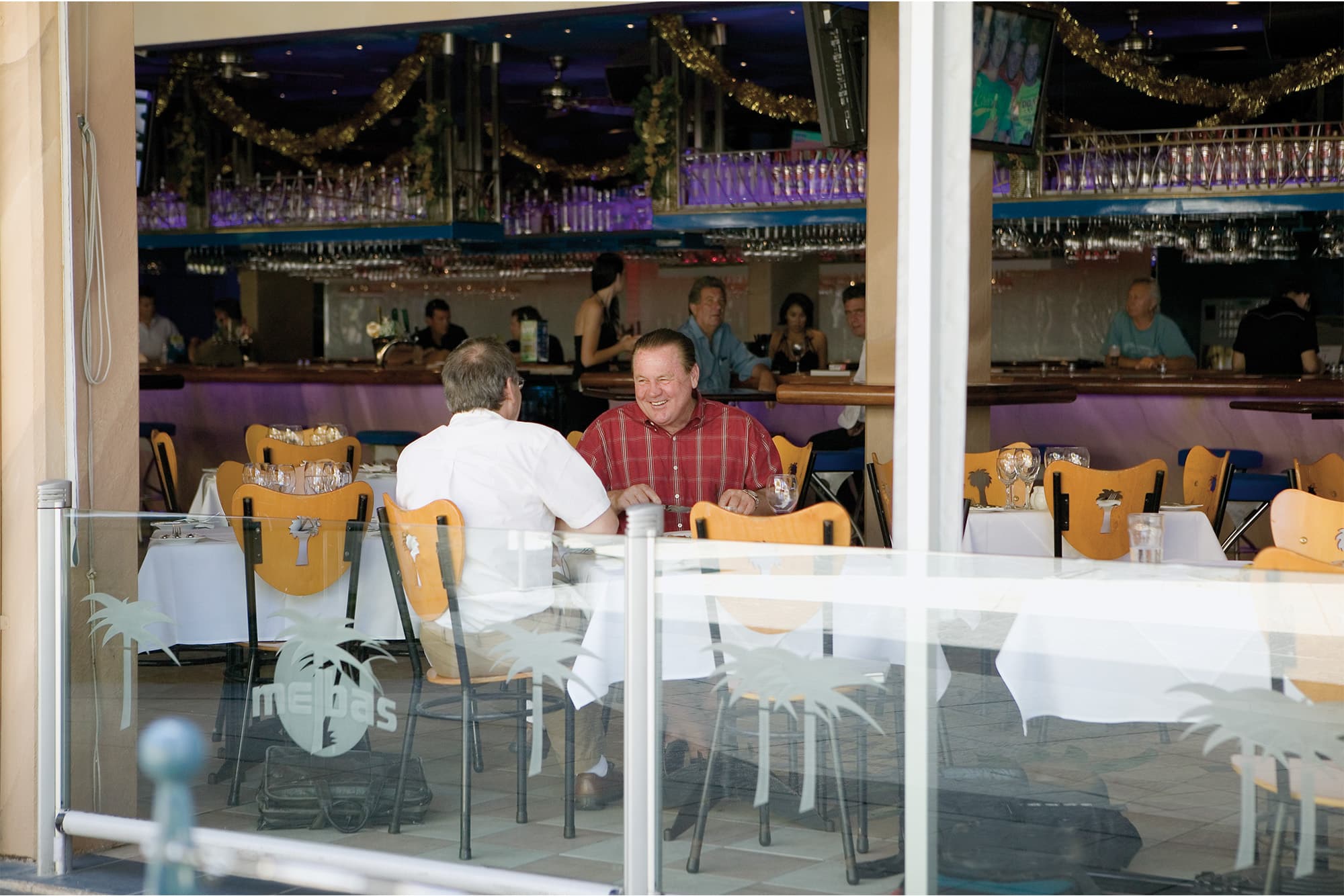Lunch with... Alan Jones
Williams’ favourite son on dodgy campers, nightmare bosses and gelling with Frank and Patrick.

John Downs
Scroll down the roster of drivers who won a single World Championship – names like James Hunt and Jody Scheckter, Nigel Mansell and Damon Hill – and for each there’s a different reason why they never took a second title. In the case of Alan Jones, it’s probably down to the English weather. Between 1978 and 1981 Alan forged a tremendously strong working relationship with Frank Williams and Patrick Head. The three men, hardened racers all, were comfortable with each other, talked the same down-to-earth language, and wasted no time on sentiment or ceremony, and together they achieved one drivers’ title and two constructors’ titles. In 1982 a Williams driver won the World Championship again – but that was Keke Rosberg, and by then Alan was driving a tractor on his farm in Australia.
“Over the winter of 1981 Patrick came up with the six-wheeler [the Williams FW07E] and Frank said I had to go to Donington to test it. I’d bought the farm, we had our son Christian, and I’d really got the shits with England. I stayed at that bloody motel at Donington, and I had to boil the kettle in my room to unfreeze the lock to get in my car the next morning. I thought, ‘This is exactly why I want to go home’. I tested the car, drove back to a cold, grey Heathrow and got on a Qantas jet. As soon as we burst through the clouds into the sunshine I thought, ‘I’m not going to miss Formula 1.’ But of course I did come back, twice. I’ve had more comebacks than Dame Nellie Melba.”
Which is appropriate, because we’re having lunch at Melba’s, a swanky restaurant and nightclub just behind the gilded beach of Surfers Paradise, where Alan lives in a waterside property with his second wife Amanda and seven-year-old twins Zara and Jack. The weather is glorious, and Alan is wearing the Gold Coast uniform of shirt and shorts. He looks healthy and relaxed as he instructs the waiter to bring a plate of oysters and a filet mignon “medium on the inside, burnt to buggery on the outside”.
Any discussion of Alan’s career has to start with his father, for during the 1950s Stan Jones was one of Australia’s top racers. “He was a colourful character. He had a string of very successful car dealerships, and he never took a back seat to anybody. Liked the whisky, liked the ladies. I was surrounded by racing cars since I was knee-high. When anybody asked little Alan what he was going to do when he grew up, I’d always say I was going to be a racing driver.
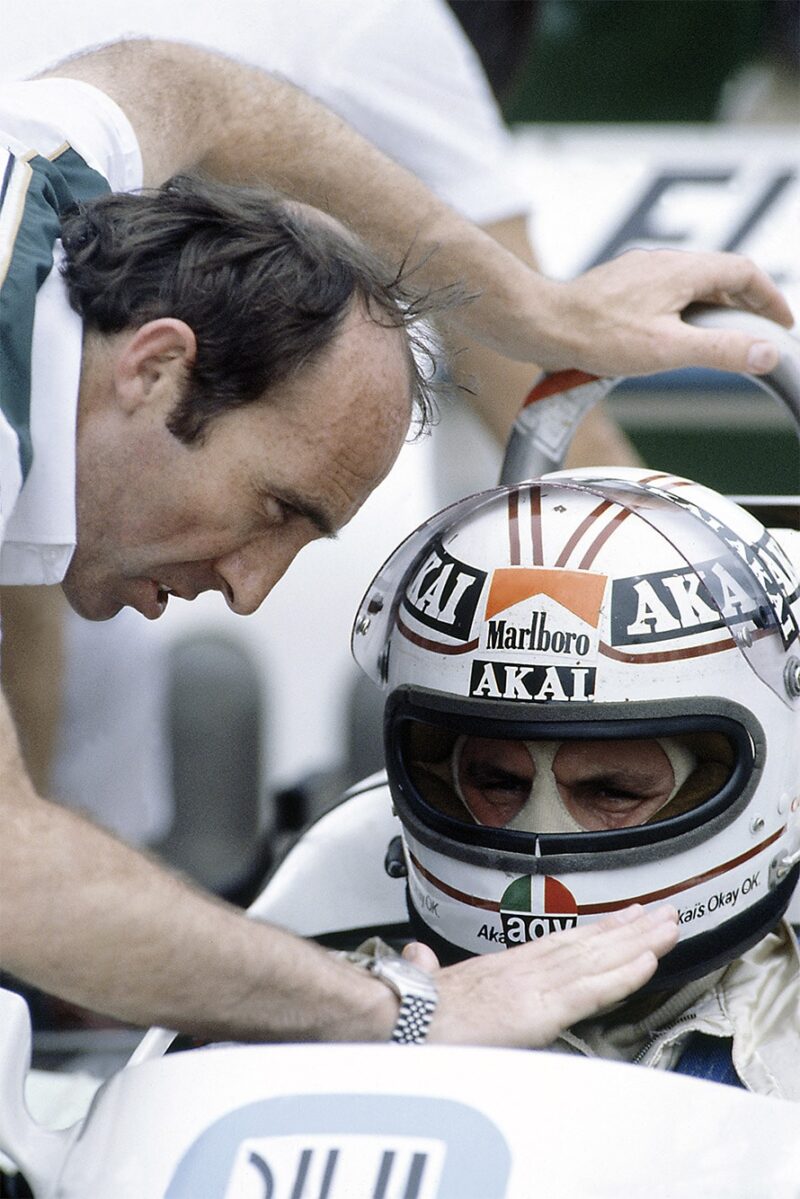
Talking tactics before the 1981 Brazilian GP. Jones says Williams was “a great motivator”
Motorsport Images
“Dad bought the famous Maybach Special, and he won the first New Zealand Grand Prix with it in 1954, against Wharton’s V16 BRM and Whitehead’s V12 Ferrari. That year he was leading the Australian GP on the old Southport road circuit. Going over the bridge, as the fuel load got lighter, the gap between the road and wheels started getting wider. Finally something broke as he landed, and he went off into the trees. Huge accident. The Maybach was cut clean in two, and all he’s done is cut his chin. Then he got a Maserati 250F from the factory – with a brand-new 300S engine as a spare. He won the 1959 Australian GP with that. He also had an F1 Cooper, and he even did the Monte Carlo Rally in a humpy Holden, in an all-Aussie effort with Lex Davison and Tony Gaze. They finished, too.
“My parents split up when I was 12, and Dad got custody of me. He was always a bloke who got what he wanted, by one means or another. We had a housekeeper to cook and clean, and I had a lot of days off school to go to the races with him. When I was 16 I started hillclimbing a Mini, and I began working in Dad’s businesses.
“Then Dad went broke. The credit squeeze hit at a time when dealers had to carry huge stocks, because if someone wanted a blue one with red seats and you didn’t have it you’d lose the deal to someone up the road. Until then I’d been a spoiled brat, a big-headed little bastard, and suddenly I had to learn some hard lessons about life. If Dad hadn’t gone bust I don’t think I’d have ended up much of a racing driver.
“I knew if I wanted to go motor racing properly I had to be in Europe. I arrived in London with £50 in my pocket, and my mate Brian McGuire and I ended up, of course, in Kangaroo Valley – Earls Court. I got a job in Selfridges, selling fireworks, but then we started to sell VW campers to poor unsuspecting Kiwis and Aussies. We’d park them in the Earls Court Road with a For Sale sign in the window, and by the time we got home the phone’d be ringing. It was money for old rope. We worked all sorts of tricks to source them. Sometimes we’d buy them for £150 and sell them a few hours later for £600. All we cared about was getting the money together to go racing.”
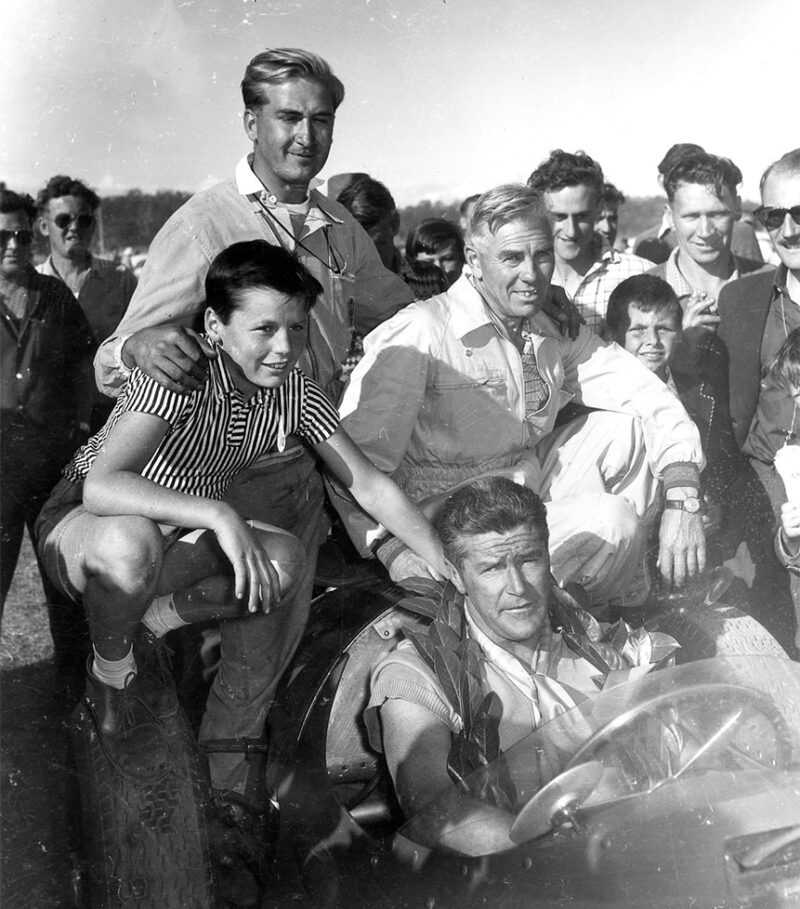
Father Stan won the 1959 Australian GP in a Maserati 250F. Alan, aged 12, joins in the celebrations
Steven Ormoyle
They bought a Formula Ford, which Brian crashed, and then Alan got a twin-cam Lotus 41, which was wrecked in a testing accident at Brands Hatch. “The guy in front dived across the road to go into the pits, I swerved to avoid him and hit the bank. I was a bit crocked, had a broken foot, so they took me to a hospital which must have been bang up-to-date in the Boer War. The lady doctor started lecturing me about how motor racing endangered life. Then she got some scissors and was about to cut off my brand new overalls. I had a major blue with her about that. Later I found out they’d operated on my foot all wrong and I had to have it done again. I patched up the Lotus and sold it.”
Next came a Brabham BT28 which, for 1971 and the new 1600cc F3, was updated to BT35 spec. With McGuire and New Zealander Alan McCully, Alan ran under the proud banner of the Australian International Racing Organisation, with cars and van smartly turned out in orange colours. “People thought AIRO was sponsored by the bloody Australian government. The paint looked good, but we had no money at all.”
What Alan did have was a good relationship with George Robinson of Vegantune, who lent him engines. “What I like about the Brits is they never worry if you’re English, or Australian, or from Timbuctoo. They just base their support on whether they have faith in your ability. I owe George a lot.”
A borrowed GRD and another Vegantune engine got Alan through 1972, and he and his new wife Beverley were now paying the bills by running a boarding house. “We rented a big house in Ealing, filled it with bunk beds bought from an Army surplus store, and put up Australians, New Zealanders and Canadians. Four rooms, four to a room, £11 a week with breakfast, it was a bloody gold-mine. I’d get up early and do the breakfasts, dish out the cornflakes and the bacon and egg, and everything had to be finished by 9am so I could piss off and spend the rest of the day hunting for a drive.”
For 1973 Robinson recommended him to the Scottish industrialist Denys Dobbie, who had grand plans for DART, his Dobbie Automobile Racing Team. Initially it was an F2 for Dave Walker, a sports car for John Miles and an F3 GRD for Alan, and there were whispers about F1 in the future. The F2 and the sports car soon fizzled out, but Alan led the British F3 Championship until the final round, when his engine blew in practice and the spare turned out to be badly down on power. He lost the title to Tony Brise by two points. By now Dobbie had had enough, and Alan spent another difficult winter wondering where his next drive was coming from. Meanwhile his father had had a stroke. “We got him over from Australia and he lived with us in Ealing. He came around the races with me, leaning on his stick. Then he had another stroke and he had to go into care. It was very sad. He died in 1973, and he was only 51. I’d just won an F3 race at Silverstone, and we put the wreath in the coffin with him.
“Then I heard that a man called Mike Sullivan needed a driver for his Formula Atlantic March. I called him at once and he came on strong: new car, big transporter, the works. I was down there almost before he’d hung up the phone. When I got to his house I saw an old Nestlé van outside. That was the big transporter, and that’s when I started to feel less excited. The car was two years old, and in its first race it overheated. But in the second, at Silverstone, I got lucky: all the people in front of me broke down or fell off, and I won. I gave Sullivan a list of things that needed doing before the next round at Oulton Park two weeks later, and when I got there nothing had been done. He’d just put the car back in the Nestlé van. So I refused to drive it, and I made sure everybody in the pits knew why.
“So Harry Stiller offered me a test. His Atlantic March really was a new one, and he had a good engine deal. But his driver, Bev Bond, had been complaining that the car had an understeer problem. I knew Robin Herd pretty well – I’d been doing some journeyman testing for March at Goodwood – and he came to the test. We dialled out the understeer, I got under the Formula Atlantic record, Bev Bond was promoted to team manager, and I had a drive for the season.” There were lots of lap records but lots of retirements, although a pole-to-flag win in the British Grand Prix support race did his reputation no harm.
And in 1975 Alan got his foot in the F1 door at last. “Harry called and told me to go to some place called Easton Neston and have a seat fitting.” Stiller had done a deal to run the original Hesketh 308 alongside James Hunt’s works car. In his first outing, in the Silverstone International Trophy, Alan finished seventh, less than a minute behind Niki Lauda’s winning Ferrari. His first Grand Prix was the dreadful Barcelona race, with the drivers’ boycott of practice and Rolf Stommelen’s crash in which four spectators died. “I remember everyone sitting around arguing about safety, and I wondered what I had got myself into. I’d gone to Spain to go racing, so I sided with the drivers who were saying, ‘Let’s get on with it and get out there’. Then came Monaco – they had 27 entrants going for 18 places on the grid, and when I scraped in 18th we felt like we’d won the bloody race. But in the race a wheel fell off.”
After four GPs with the Hesketh, Harry Stiller moved to the USA for tax reasons. With Stommelen still injured, Graham Hill offered Alan a seat alongside Tony Brise for four races. His fifth place at the Nürburgring was the Hill GH1’s best-ever result. “Having been World Champion, Graham felt he knew better than his drivers how to set up the car. He was stubborn and inflexible. A great ambassador for motor racing, but a wretched man to work for.” Then Stommelen returned and Alan slid backwards into Formula 5000, driving John Macdonald’s V6 March to two victories and five fastest laps. He was determined to get back into F1, but the future looked bleak. The inevitable midnight phone call from Louis Stanley promised the world at BRM, but: “I just didn’t believe him. However desperate you are, there are some cars you don’t want to drive, and some people you don’t want to drive for.
“Then John Surtees gave me a run at Goodwood – which I knew well after all those March sessions – and he offered me a drive on the spot. He was off to South Africa testing, and asked me to go. At Heathrow he waved a piece of paper at me. It was a two-year contract, and he said, ‘Sign this, or you’re not coming.’ I said, ‘Hold on, John, we’re in the departure lounge. I’d quite like the chance to read it through.’ He said, ‘I’m not paying all this money to get you down there unless you sign.’ I skimmed through it and we started to argue about it all. The airline staff were chasing us because we were keeping the Jumbo waiting. So I signed.
“We were at Kyalami for a week and I think I did six laps, because the uprights kept breaking. Then came the Race of Champions at Brands Hatch. There was uproar because BBC TV were refusing to televise the meeting, all because our Surtees had the terrible word Durex written in big letters across the nose.” The broadcaster didn’t want the name of a contraceptive to appear on screen, but cynics were saying it wouldn’t be a problem, because a Surtees was unlikely to be anywhere near the front, so the cameras wouldn’t show it anyway. “And when I got to Brands there was no sign of my car. It transpired they were still finishing it in the transporter on the way to the track.

Fifth at the Nurburgring in 1971 was Hill GH1’s best result
Motorsport Images
“Well, for the race it was cold and slippery. At the start Scheckter pissed off into the distance – I think Tyrrell ran lots of toe-in to get some false heat into the tyres – but on lap two he threw it into the bank, and I’d just passed Niki Lauda’s Ferrari, so I was in the lead. I held off James Hunt’s McLaren for about half the race, and by the end I was still second, so that was good. But two weeks later we were at Long Beach, where it was warm and dry, and we were nowhere.
“John would always go through this time-wasting ritual in practice, trying endless small adjustments. He’d fiddle with the car, I’d do some laps, tell John what I thought the car needed, he’d fiddle some more, I’d do some more laps, and by the end of practice we’d just manage, with luck, to get the car back to where it was when we’d started. John said to me once, ‘The reason why the car isn’t quick enough is because the chassis is too good, it’s not putting enough heat into the tyres.’ So I said, ‘Well, John, why don’t you just fuck it up a little?’ Basically it was a good car, and we scored fourth and fifth place points on occasion, but it was a frustrating season. The two most difficult men I’ve ever driven for have been ex-World Champions. At the end of the first year of my two-year contract I said to myself, ‘If the only way I can do F1 is with Surtees, I’m not doing it.’
“I did the Tasman races in Teddy Yip’s F5000 Lola – I won the Australian GP, 18 years after Dad, but I’d jumped the start so they demoted me to fourth – and then Teddy said, ‘Come and try Indycar racing on the ovals.’ We went to Ontario with a McLaren M16, and I’ve never worn overalls for so long and done so little driving. We had to wait three days for the wind to drop before they let us out. It seemed every time an aeroplane flew by and cast a shadow over the track they’d stop running. I didn’t like it, I didn’t like the ovals, it was weird.
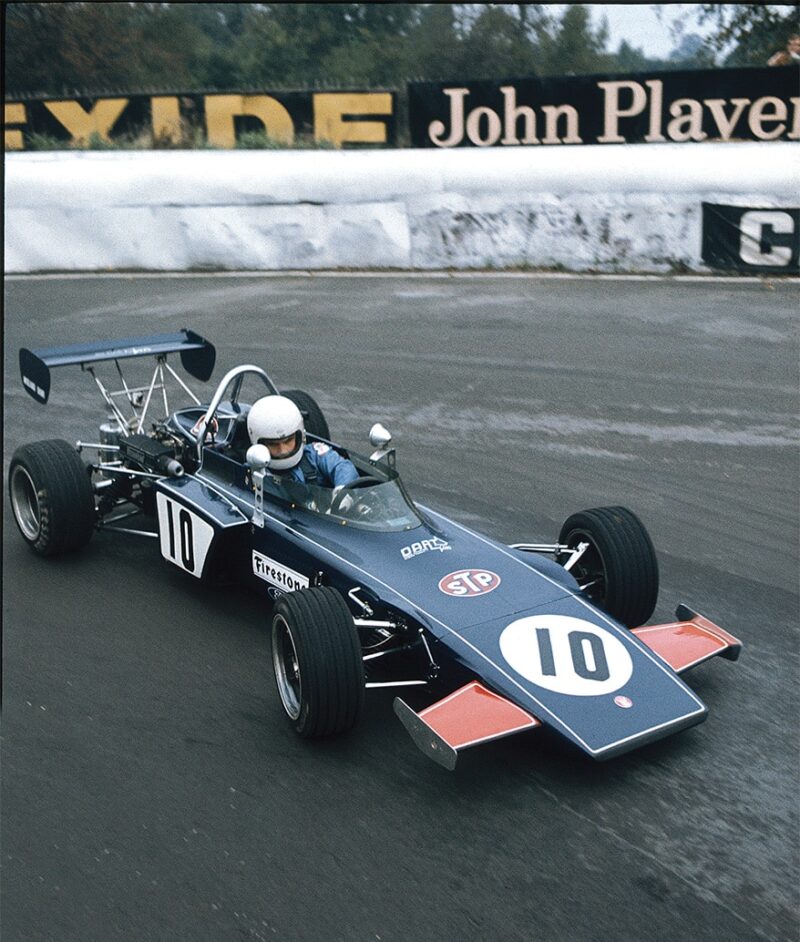
AJ came close to the British F3 title with a Dart in 1973
Motorsport Images
“Then Tom Pryce was killed at Kyalami, and Jackie Oliver came on the phone. ‘What are you up to, Alan?’ ‘Nothing much.’ ‘Come and drive for Shadow.’ ‘Well, trouble is I’ve got this contract with Surtees.’ ‘Let me handle that,’ said Jackie. I don’t know what happened, but he did handle it, and I became a Shadow driver for 1977. Don Nichols was a bit different – anybody who wears a black hat and a black cape is a bit different – but Alan Rees was a good team manager, he made things happen. We had a podium at Monza and a couple of fourths. And I won the Austrian GP.”
On a damp and slippery Österreichring Alan started 14th, and carved his way up to eighth by lap nine, fourth by lap 12 and second by lap 16. It was an inspired drive, and when Hunt’s McLaren retired with 10 laps to go he took Shadow’s only GP win. “It was a big surprise to everybody, including the organisers, who didn’t have the Australian National Anthem ready. Some drunk played Happy Birthday To You on the trumpet instead. I didn’t mind a bit.”
The joy of his victory was tainted a couple of weeks later when his old friend Brian McGuire was killed racing a two-year-old Williams FW04 in the British Aurora Championship. A pin came out of the brake linkage at Brands Hatch and he hit a marshals’ post. “I used to say to Brian, ‘Look, mate, when these cars were new they were taken back to the factory after every race, stripped down to nothing and rebuilt. You can’t just put them through a car wash.’ I always worry when I watch people racing F1 cars from my period. Most are properly prepared, but there’s a few people who buy them and don’t give them the attention they need. You could get killed in them when they were new, and since then the barriers haven’t got any softer.”
The Austrian win was a big turning point in Alan’s career. “Because I was going well in a Shadow, people were saying, ‘Look at Jonesy, he’s doing well in that old shit-box, isn’t he?’ At the end of the season Frank Williams rang me and said he was interested, but then I got a summons: come over to Maranello and meet the old man.

Jones and Head spoke the same language
Motorsport Images
“First off, Luca di Montezemolo said to me, ‘When you meet Mr Ferrari he will ask you why you want to drive for Ferrari. Make sure you have your answer ready.’ I should have thought it was pretty obvious why I wanted to drive for Ferrari. Piero Lardi showed me round the facility, which was amazing especially for those days – the foundry, the test track, everything – and then I was taken to Mr Ferrari’s villa. They ushered me into the presence of this white-faced figure with dark glasses, and my first thought was, ‘He’s dead. They’ve propped him up and they’ve got a recording of his voice coming from behind a curtain.’ He asked me why I wanted to drive for Ferrari and I must have given the right answer, because they gave me a contract, and I signed it. Part of the deal was I had to live in Modena, which was no drama for me. Then they said, ‘We want a North American driver because it helps our road car sales in the USA, so we’re trying to sign Mr Andretti. If we don’t sign him, you are a Ferrari driver for 1978.’ That seemed pretty straightforward.
“Two weeks later I read in the comics that Mario Andretti had signed for Lotus, so I thought, ‘How good’s this – I’m a Ferrari driver.’ I called Maranello and said, ‘When do you want me?’ ‘We don’t,’ they said. ‘We’ve signed a North American – Gilles Villeneuve.’ So I hung up, dialled Frank’s number, and said, ‘Frank, I’ve been giving a lot of thought to your offer…’
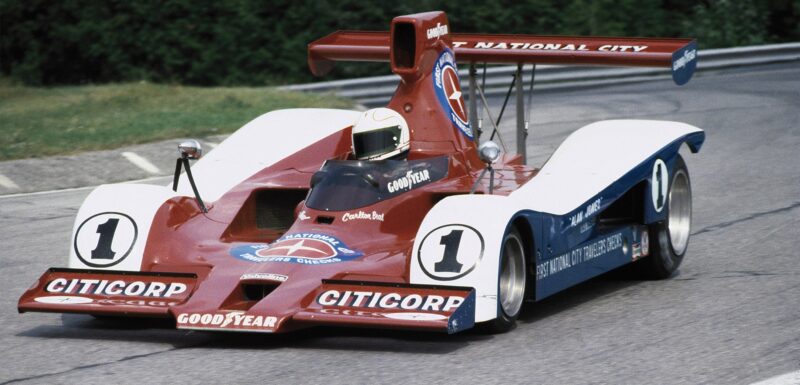
Can-Am title-winning campaign for Carl Haas dovetailed with F1 in 1978
Motorsport Images
“By signing Villeneuve, Ferrari had done me the biggest favour of my life. I met Frank; typically he went all clandestine on me, and we had a secret tryst in a lay-by at the side of the M1. Then I went to the factory, saw the FW06, and met Patrick Head for the first time. I was unbelievably impressed with Patrick. Compared to what I’d come to expect in Formula 1, he just seemed so down-to-earth. It was a one-car team, and I was a bit worried that the 06 wasn’t ground-effect, but what I did like were the five letters painted on it, SAUDI, because that meant it was properly funded. What I didn’t realise was that, although the signage was on the car, the deal wasn’t done yet. I’ve always reckoned the first two GPs of 1978 were done on Frank’s credit card.
“By the time we got to the fourth round, at Long Beach, the young princes and a lot of the top Saudis were there. I was up the backside of Reutemann’s Ferrari and pushing him hard for the lead. The nose wing started to collapse, but I didn’t notice any difference. But then a misfire set in. Reutemann spun later, so we would have won that one. The 06 was a clever little car, and it should have won a race, but the team was on a steep learning curve. The nearest we got was second at Watkins Glen.”
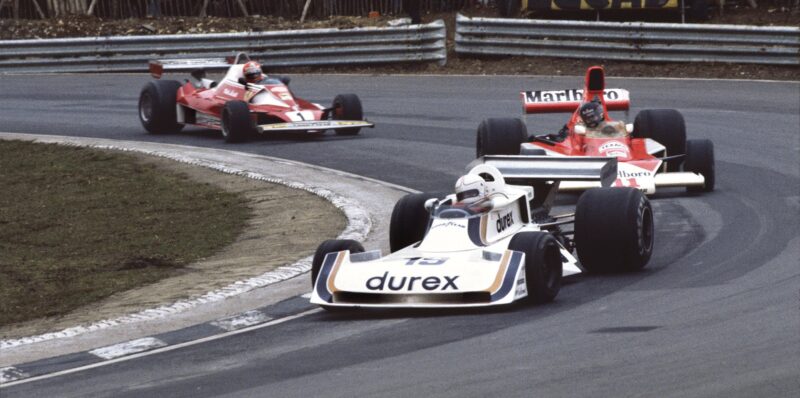
Leading Hunt and Lauda in 1976 Race of Champions
Motorsport Images
It was a busy year, for as well as the F1 programme, Alan also won the Can-Am Championship with a Carl Haas Lola. “I’d do F1 one weekend, then go testing for Frank in the week, then fly to America for the next weekend’s CanAm. But Carl had a good set-up, and it was pretty much C&C – cruise and collect. The boss of CityCorp couldn’t believe I commuted from England for each race, and he said to Carl, ‘This boy has to fly Concorde.’ ‘Good idea,’ says Carl, ‘if you want to pay for it.’ So he did.
“The Concorde lounge at Heathrow gave you free international calls, so I’d camp outside the door waiting for it to open like it was a Harrods sale, to get all my phone calls done on the house.” Still lurking inside this jet-setting F1 driver was the struggling hustler who’d cooked breakfast for his tenants in the Ealing boarding house.
Alan’s rugged personality fitted the Williams team like a glove. “Patrick and I had a fantastic relationship. We understood each other so well that he could almost double-guess me. If I wanted an adjustment on the grid after doing the warm-up lap, he’d know precisely what I wanted almost before I asked for it. Frank was more involved in the business side, doing the deals. During debriefs in the motorhome Patrick would take me through everything, and then all of a sudden Frank would pipe up, ‘Driver comfort OK?’ Every debrief he said it. Finally one day I said, ‘Shit no, Frank, I’m not too comfortable.’ It made his day! Frank is the best bloke I ever drove for, because he was such a great motivator. He could make you walk over glass. He was, and still is, a bloody racer. I cannot in all honesty fathom how he and Patrick still go to the races they go to, year in and year out. It’s been nearly 40 years for Frank now…”
For 1979 Clay Regazzoni joined as Williams’ number two, and Head came up with FW07, with full ground effects. “It was a bit late coming, so we did the first four rounds with 06. When I first got into 07 I did five laps and came in and said to Patrick, ‘Now I know why Andretti and Lotus have been winning all those races.’ The grip going into corners, the commitment you could make, was just unbelievable compared to what I’d been used to. We led Zolder until the electrics failed, and then at Silverstone we had pole, murdered the lap record, and led all the way until the water pump sprung a leak. Regazzoni was running behind me, so he scored Williams’ first win. But I won four of the next five GPs – Hockenheim, Österreichring, Zandvoort and Montréal.”
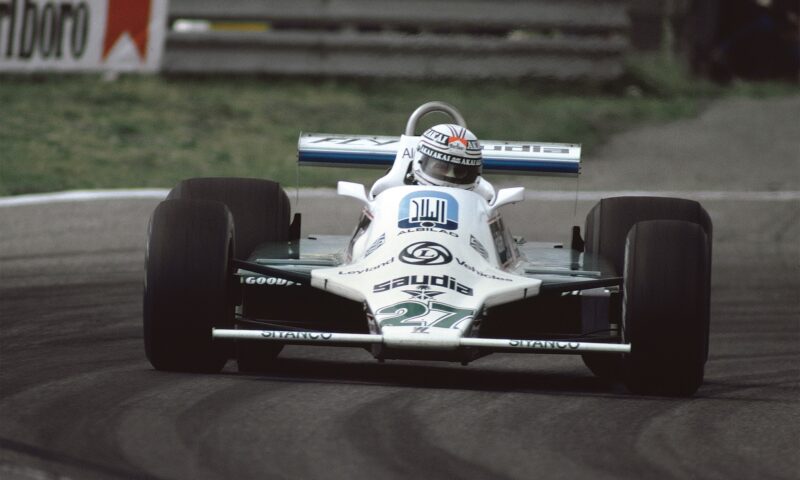
Jones and Williams dominated F1 in 1980
Motorsport Images
This string of late-season victories promoted Alan to third in the 1979 World Championship behind Scheckter and Villeneuve, with more wins than either of them. And in 1980 the job got done. After a stirring battle with Brabham and Nelson Piquet, Alan was World Champion, with five victories, and Williams was champion constructor. His team-mate was now Carlos Reutemann. “All the stories that Reutemann and I hated each other are bullshit. He was no different from any of my team-mates. I never said to any of them, ‘Come round for a barbie,’ because I had to race against them, and I wasn’t going to give them anything.
“But the last thing Frank wanted was his two drivers having each other off, and if you own the bloody team you call the tune. So he wrote into Carlos’ contract that if we were more than 10 seconds ahead of everybody else, and we were separated by less than two seconds, I would win. Carlos read the contract, and he signed it, and I didn’t see anyone holding a .45 to his temple. In fact it only ever arose on one occasion, at Rio in 1981. It was pissing down, and we took off into the distance with Carlos ahead of me. I thought, if I stay within 2sec of him he’s got to let me through. It’s getting closer and closer to the end of the race, the pit signal goes out JONES-REUT, and I think, ‘What’s going on here?’
“Then I thought, ‘I know what he’s going to do, he’s going to play Mr Obvious and move across for me on the last lap where everybody can see.’ So I carried on sitting behind him. But he just kept going and won the race. I got out of my car and went to the podium, which wasn’t in the main body of the pits, and after standing in the rain for what seemed like a long time with nothing happening I went back to the paddock. This was interpreted as me getting the shits with Carlos and storming off, but that’s not what happened. The next round was in Argentina, home ground for Carlos, and in Buenos Aires I had taxi drivers giving me the finger. Even the bloody marshals at the track were giving me the finger. People were blowing it up into something it wasn’t, but the team orders scenario never came up again.” But Frank Williams, annoyed that Carlos had ignored the agreement, only paid him second-place money for Rio.
Among his other contemporaries, Alan singles out Ronnie Peterson. “I always got on well with Ronnie. Everybody knows about his fantastic car control, but he was so naturally gifted that he had no idea why he was quick. He couldn’t analyse it. That’s why he was no good as a test driver: give him a problem and he’d just drive around it. With Gilles Villeneuve you always had a fight on your hands. He was very tough to drive against, but he was always fair. Mind you, when he had that puncture at Zandvoort in 1979, and just kept on racing with a back wheel hanging on by a brake line, he behaved like a dickhead. I wouldn’t want to be the guy following when the brake line snaps and his wheel comes flying into my cockpit.”
Alan arrived at Monza in 1981 with a broken finger on his gear-change hand, the legacy of an altercation with two thugs in a London street after a traffic incident (in which you assume Alan gave as good as he got). That weekend he quietly told the team, to Frank’s dismay, that he wanted to retire, and then he climbed through the field to finish second. In the final round at Las Vegas the outgoing World Champion led from start to finish to score his 12th GP victory, then turned his back on F1 and dug in on his farm north of Melbourne.
“We had 2200 acres, breeding Simmental cattle and Charollais sheep, and it was a full-on operation. I was sick of the travel and I thought, ‘Great, I’m never going to see another airport again.’ Pironi had his accident at Hockenheim in the August, and when Ferrari came on the phone I didn’t take the call. It was stupidity on my part, I was just being bloody-minded, and I really regret it now. They gave the drive to Andretti, and he took pole for them at Monza. He’s never paid for a plate of spaghetti since.
“I was cutting the 100-acre paddock by the main house, sitting on this tractor for bloody hours, and a plane went over high in the sky and I caught myself thinking, ‘Jeez, I wonder where that’s going?’ Then I fell off a horse and broke my femur, and while I was laid up Jackie Oliver came on the phone and said, ‘It’s all happening at Arrows, we’ve got a major new sponsor, come back and drive.’
“So I got my femur pinned, flew to the States and did the Long Beach race. I had to bash the side of the monocoque with a hammer to clear my bad leg.” He qualified mid-grid and ran eighth, but eventually retired when the cockpit chafing the pins in his leg made it too painful to continue. He was third in the Race of Champions two weeks later, but “the mysterious billionaire sponsor was showing no signs of appearing, there weren’t the funds to go testing and develop the car, so in the end I just said, ‘No.’
“Back home a friend who was Australia’s Porsche distributor got me racing a 935, and then in 1985 I got a call from Charlie Crichton-Stuart, who’d been a good mate when he was working with Frank Williams. He was full of a new F1 deal that was going to be wider than Cinemascope and brighter than Technicolor. He said, ‘I’ve been told to sign you. They told me to offer you X, but if I have to I can go to X plus Y. So why don’t I just offer you that?’
“What was going on was Beatrice, the eighth- largest company in America, had decided to go F1. Carl Haas was putting it together, and it sounded good enough to get my overalls back on. Goodyear, Lola, exclusive use of a new Ford V6 turbo engine, smart new factory, all the kit.And lots of money. All the ingredients to bake the cake, but they couldn’t turn the oven on.”
So why didn’t it work? “Well, it’s debatable how good the chassis was, but the engine was shit. Beautiful little engine, beautifully put together, but no horsepower. The Hondas had electronically variable turbo boost, but we had to do it manually, with two plastic things coming out of the dash. You could only adjust the boost on constant revs on the straight, so you’d do one bank on one lap and then you’d have to wait another lap before you could do the other bank. They were coming up with all this bullshit, F1 was going to see American muscle at its best, but we were 20kph slower down the straight than the Ferraris. Teddy Mayer was the team manager, and in my opinion he was hopeless. Other people will disagree with that, but Teddy didn’t have a good way about him. There’s ways to get the best out of drivers, and he found out how not to get the best out of me.” Alan did 20 Grands Prix for Beatrice. The tally was 15 retirements, one non-start – and just four points. The Beatrice episode paid well, but brought no joy.
“So I came home and went touring car racing. Australian touring cars are pretty serious, 600bhp and under-tyred, and very competitive. I really enjoyed that. My last race was Bathurst about five years ago. Then the Masters: loved the idea, loved the car, but at Kyalami in practice for the first race I rooted my neck. I’ve had a dickey neck for a while and when it seizes up it affects everything, even my vision. I wasn’t kidding myself, I was nowhere near as quick as I should have been. So I turned into a bloody expert and did the commentary with Murray Walker. That was fun. Now I’m involved with the Australian A1GP team: 10 rounds, and I go to every one. I love getting to the track early in the morning, discussing pitstop strategy and which way to go on set-up. I enjoy helping the drivers [currently John Martin], we go through the data and I’ll offer advice, but no way do I tell them what to do. I don’t want to do a Surtees and try to get back in the cockpit with them.”
Alan’s son Christian went via karting to Formula Ford, and in 2004 he won the Asian F3 Championship. He was Australia’s A1 driver in 2005, and has raced in the Porsche Supercup. “And this very morning, in the swimming pool at home, seven-year-old Jack said, ‘You know, Dad, I might be a racing driver when I grow up.’” Stan would be pleased to know that the Jones genes are all present and correct.
